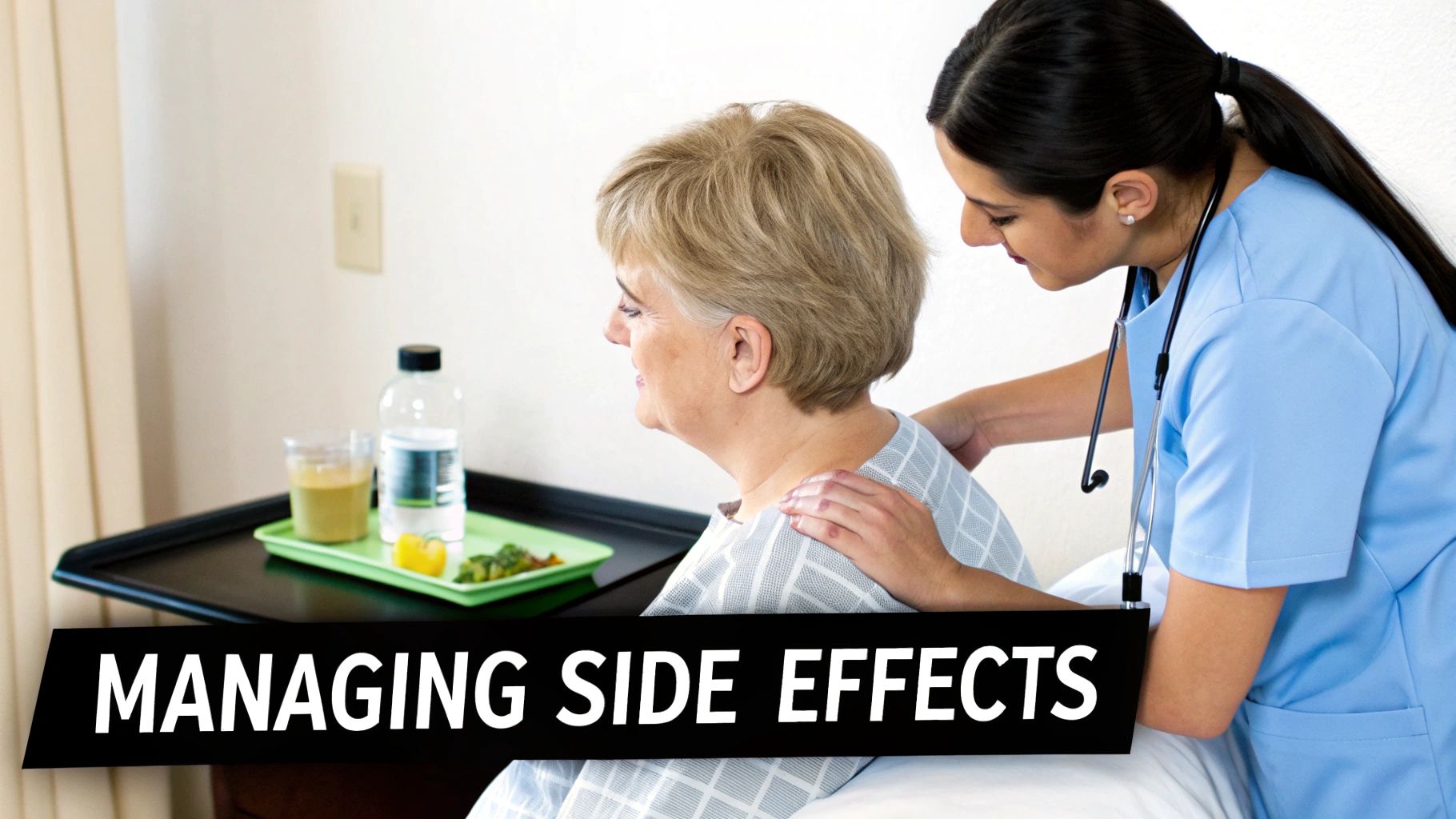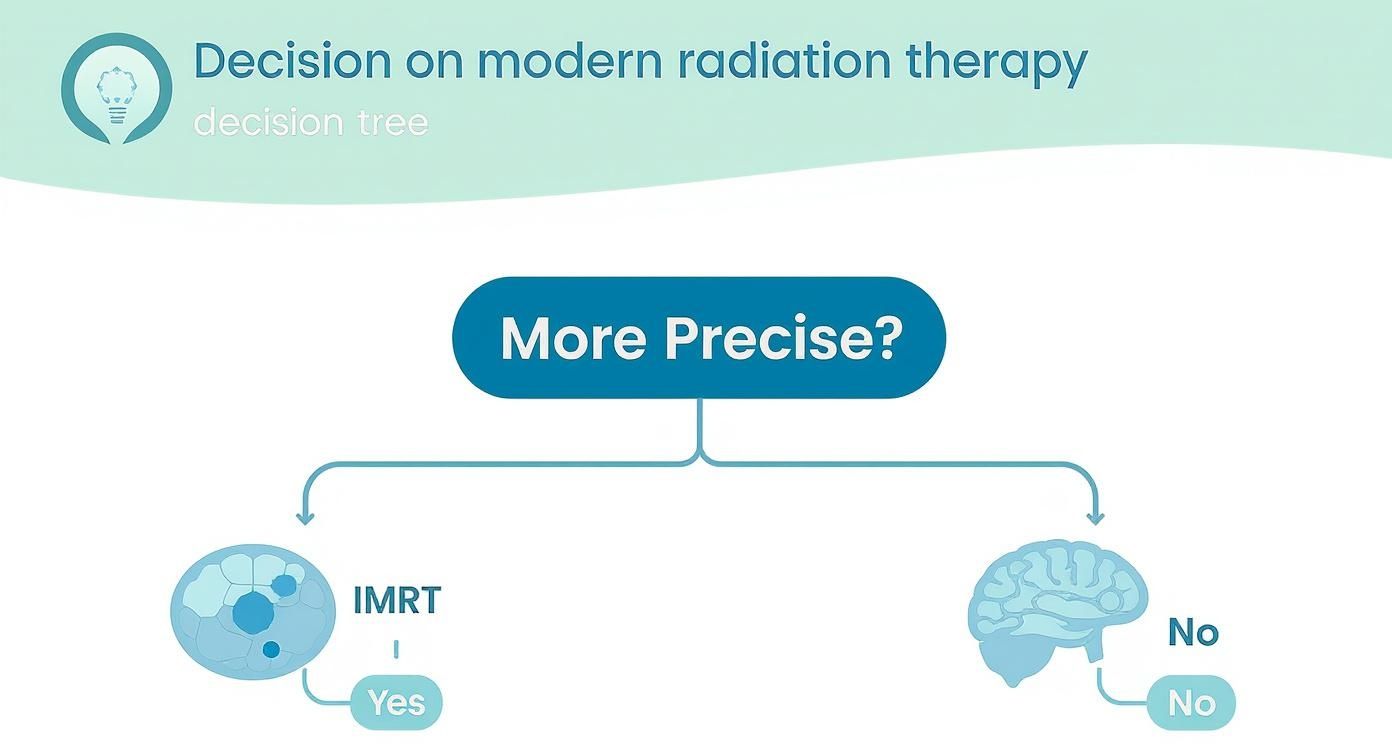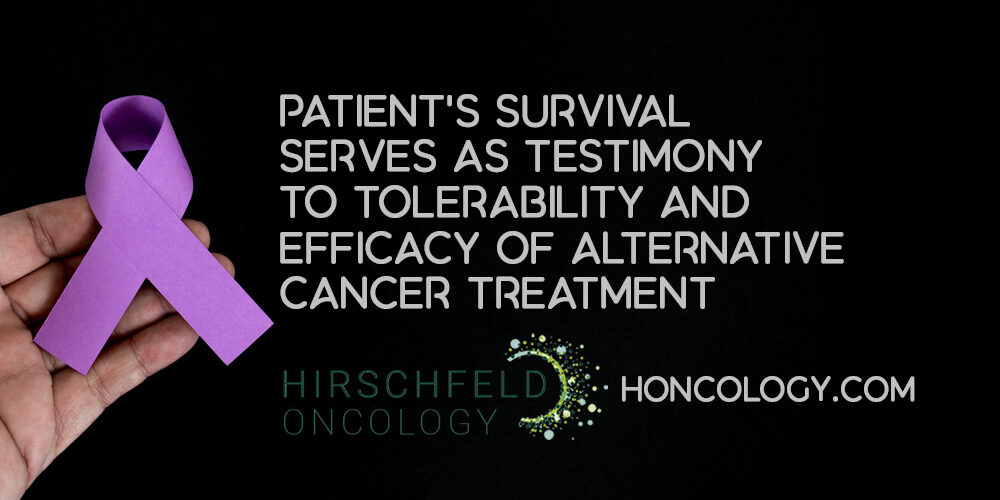Radiation therapy is incredibly effective at targeting and destroying cancer cells, but it's not a perfect science. The high-energy rays that are so damaging to tumors can also affect the healthy tissues they pass through on their way to the target. This collateral damage is what causes side effects.
The specific side effects a person might experience are completely dependent on what part of the body is being treated and the dose of radiation used. They can range from temporary issues like skin redness and tiredness to more lasting complications that might not show up for years.
Understanding Why Radiation Causes Side Effects

Radiation therapy is a powerhouse in modern cancer treatment—in fact, more than 50% of all cancer patients will receive it at some point. The core mission is simple: to scramble the DNA inside cancer cells so they can no longer multiply and grow.
But this powerful beam can’t always distinguish between a cancer cell and a healthy one. Think of it like a carefully aimed spray meant for weeds in a flowerbed. You're trying to hit just the weeds (the cancer), but some of the spray inevitably lands on the flowers (your healthy cells).
The good news is that your healthy cells are generally much better at repairing this kind of damage than cancer cells are. This difference is precisely what allows radiation therapy to work so well. The adverse effects of radiation therapy you feel are simply the signs that your healthy cells in the treatment area are being affected and are working hard to recover.
For instance, if radiation is aimed at a tumor in your pelvis, it might irritate the nearby bladder or bowel. If it’s targeting your neck, you might notice a sore throat or changes in your salivary glands.
Acute vs. Late Effects: A Key Distinction
To really get a handle on side effects, your oncology team thinks about them in two different timeframes: acute and late. This isn't just medical jargon; it's a critical distinction that helps everyone understand what to expect, how long it might last, and the best way to manage it.
Acute Effects: These are the side effects that pop up during your treatment or just a few weeks after it finishes. They are your body's immediate reaction to the radiation. The most common ones, like fatigue or skin looking a bit like a sunburn, are usually temporary and fade away once treatment is over.
Late Effects: These are a different beast altogether. Late effects can surface months or even years after you've rung the bell and finished your last radiation session. They tend to be less common but can be permanent, like tissue scarring (fibrosis) or chronic swelling (lymphedema).
Your medical team is thinking about these potential side effects from day one. During treatment planning, they use sophisticated technology to shape the radiation beams, sparing as much healthy tissue as possible. They have a game plan ready to help you manage any symptoms that do appear.
This next part breaks down the differences between acute and late effects even further.
Acute vs. Late Side Effects At a Glance
This table offers a clear, quick comparison to help you understand the different timelines and characteristics of radiation side effects.
Having this framework helps set realistic expectations for your treatment journey and gives you a better understanding of the road to recovery.
Navigating Acute Side Effects During Treatment

As you start radiation therapy, your body gets to work on a massive cellular repair project. This process requires a huge amount of energy, which is why one of the most common acute side effects is a profound sense of fatigue. It's not just feeling sleepy; it's a deep, whole-body exhaustion that sleep doesn't always seem to fix.
This fatigue often builds a few weeks into treatment and can stick around for a month or two after you’re done. Think of it as your body pouring all its resources into healing the healthy tissues caught in the crossfire. The best thing you can do is listen to your body and give yourself permission to rest.
Beyond this general weariness, most other acute adverse effects of radiation therapy are what we call "site-specific." This means they show up exactly where the radiation beam enters and exits your body.
Common Site-Specific Reactions
The specific challenges you might face really depend on where you're being treated. The good news is, your oncology team knows exactly what to expect and has a plan in place to help you manage these reactions from the get-go.
Skin Reactions: The skin in the treatment area often acts like it has a bad sunburn. It might get red, feel tender, itch, or even start to peel. This typically kicks in 2 to 3 weeks into therapy and can be soothed with gentle, fragrance-free moisturizers and by keeping the skin away from direct sun and tight clothing.
Mouth Sores (Mucositis): For those getting radiation to the head or neck, the delicate lining of the mouth and throat can become inflamed. This can lead to painful sores, trouble swallowing, and changes in how food tastes, making good nutrition a real challenge.
Nausea and Digestive Issues: When radiation is aimed at the abdomen or pelvis, it can easily irritate the stomach and intestines. This might cause nausea, vomiting, or diarrhea, but these can often be managed with medications and simple dietary changes.
It’s important to remember that these symptoms are just your body’s response to the treatment. They are not a sign that something is wrong—in fact, they show that the radiation is doing its job in the targeted area.
The key is to stay ahead of these side effects. If you're open with your care team about how you're feeling, they can jump in with medications, product recommendations, and practical strategies to keep you as comfortable as possible.
Understanding Symptom Timelines
Most acute side effects follow a predictable rhythm. They don't usually show up after the first session but tend to appear gradually over the first few weeks of treatment. Symptoms often hit their peak near the end of your radiation course or in the week right after it finishes.
Once you're past that peak, your body’s healthy cells can finally start to catch up and recover. Your skin will begin to heal, the fatigue will slowly lift, and any digestive issues will start to fade. This recovery phase is a crucial part of the journey. For a deeper dive, check out our guide on managing side effects of cancer treatment.
While most of these effects are manageable at home with your team's support, some can become more serious. Research shows that a small percentage of patients with solid tumors might need hospitalization for complications. The most common reasons include bladder inflammation (radiation cystitis) at 4.8%, intestinal inflammation (gastroenteritis and colitis) at 3.7%, and esophageal irritation (esophagitis) at 3.5%. You can learn more about these specific radiation therapy complication statistics.
Knowing when to call your clinic is critical. Always let your doctor know about severe symptoms right away. Catching things early can prevent bigger problems from developing, ensuring you can continue your treatment safely and with the best quality of life.
Of course. Here is the rewritten section, focusing on a natural, human-expert tone while preserving all the original information and formatting.
Understanding Long-Term and Late Side Effects
It's completely normal to think about what happens after treatment is done. While we focus a lot on managing side effects during your radiation sessions, the conversation doesn't stop there. Some effects can show up months, or even years, down the line. We call these late effects.
I often tell my patients to think of it like a deep cut healing. The surface closes up relatively quickly, but the tissue underneath—the scar—continues to remodel and change for a long time. Late effects from radiation are a bit like that. They're the result of slow, gradual changes in the healthy tissues that were near the treatment area.
These changes often involve the development of stiff scar tissue, a condition called fibrosis, or damage to tiny blood vessels, which can reduce blood flow. While these late effects are less common than the immediate ones, knowing what to look for is a crucial part of your long-term health plan as a cancer survivor.
Common Types of Late Effects
Late effects are always tied to the specific part of the body that was treated. Someone who had radiation to their chest will have a very different set of long-term considerations than a person treated for a pelvic cancer. The point isn't to worry you, but to give you the knowledge to be proactive about your health with your doctor.
Here are a few examples of what we monitor for:
Fibrosis: This is simply the medical term for scar tissue building up. It can make skin, muscles, or even internal organs feel tight and less flexible. For example, after radiation for breast cancer, it can change the texture of the breast tissue. Following chest radiation, it might impact how well the lungs can expand.
Lymphedema: Sometimes, radiation near lymph nodes can disrupt the body's natural plumbing system for draining fluid. This can cause a persistent swelling in an arm or leg, known as lymphedema. It's a manageable condition, but it often requires ongoing care like compression sleeves and specialized physical therapy.
Secondary Cancers: This is a big concern for many people, but it’s important to see the whole picture. The risk of radiation causing a new cancer down the road is very low. Still, it's a known, rare possibility that your oncology team thinks about carefully when they weigh the proven benefits of your treatment against this small long-term risk.
The most important thing to remember is that your follow-up care is specifically designed to catch any of these issues early. Your regular check-ups and being open with your doctor about any new symptoms are the best tools you have for staying healthy for life.
Monitoring for Organ-Specific Issues
Some organs are more sensitive to radiation, which is why we keep a close eye on them for years. For instance, anyone who receives radiation to the chest area needs to be aware of potential lung issues. Research shows that clinically significant radiation-induced lung injury (RILI) happens in about 5% to 25% of patients treated for cancers in the chest, though that number drops to a much lower 1% to 5% for breast cancer patients. Since these complications can appear anywhere from 6 months to decades later, it really drives home the need for consistent, long-term follow-up. You can read more about the science behind this in the radiation therapy research on Wikipedia.
Other specific areas we watch include:
- Heart: Radiation to the chest can increase the long-term risk of heart-related problems.
- Bowel: Treatment to the pelvic area can sometimes lead to chronic changes in bowel function.
- Brain: Radiation to the head may, over time, cause subtle changes in cognitive function.
All of this underscores why your relationship with your medical team becomes a lifelong partnership. But it's not all on us—your lifestyle choices make a huge difference, too. Staying active, maintaining a healthy weight, eating well, and not smoking can all significantly lower your risk of late complications. By staying informed and working with your team, you can confidently take charge of your health for many years to come.
How Modern Technology Minimizes Side Effects
The core challenge in radiation therapy has always been a delicate balancing act: how do you deliver a dose strong enough to destroy a tumor while protecting the healthy tissue right next to it? For years, the approach was a bit like using a wide-spray garden hose to water a single flower—you couldn't help but get the surrounding area wet.
But today, we’ve traded that hose for a set of tools that work more like a precision water dropper. This fundamental shift has completely changed the patient experience, directly tackling the adverse effects of radiation therapy. The guiding principle behind this evolution is conformality, which is just a technical way of saying we now shape the radiation beam to match the exact 3D contours of a tumor.
By wrapping the dose tightly around the target, we can hit the cancer hard while sparing critical structures that might be only millimeters away. It’s the difference between lighting a room with a floodlight versus pointing a laser beam. That precision isn't just about better cancer control; it's about preserving your quality of life both during and after treatment.
Advanced Techniques for Precise Targeting
Your oncology team now has a whole toolkit of sophisticated methods to plan and deliver radiation. These technologies work in concert to build a treatment plan that’s tailored specifically to your anatomy and your tumor. Two of the most significant leaps forward are Intensity-Modulated Radiation Therapy (IMRT) and Proton Therapy.
Intensity-Modulated Radiation Therapy (IMRT): This is a much smarter way to deliver traditional photon radiation. Instead of one large, uniform beam, IMRT uses thousands of tiny, computer-controlled "beamlets." We can adjust the strength of each individual beamlet, essentially letting us "paint" the radiation dose onto the tumor with incredible detail and sculpt it around sensitive organs.
Proton Therapy: This approach uses protons instead of the X-rays (photons) found in conventional radiation. Protons have a unique physical property that gives them a huge advantage: they release almost all of their energy right at the tumor and then stop cold. There’s virtually no "exit dose" that continues on through the body, which is a game-changer for tumors near vital structures like the brainstem, spinal cord, or heart.
These aren't just incremental improvements on a lab bench. In the clinic, this technology means preserving a patient's ability to swallow or protecting their heart from long-term damage.
Real-World Examples of Sparing Healthy Tissue
Where this technology really proves its worth is in its practical applications. By meticulously mapping out the tumor and nearby organs, we can design treatment plans that intentionally limit the radiation dose to healthy tissues, which is the key to reducing side effects.
Head and Neck Cancers
A classic problem when treating head and neck cancers is protecting the salivary glands. If they get too much radiation, the result can be a permanent, severe dry mouth called xerostomia, which makes it hard to talk, taste, and even increases the risk of dental problems. With IMRT, we can literally curve the high-dose radiation field around the glands, dramatically lowering the risk of this life-altering side effect.
Lung and Breast Cancers
When treating tumors in the chest, safeguarding the heart and lungs is paramount to prevent future cardiac or breathing problems. We can use simple but brilliant techniques like Deep Inspiration Breath Hold (DIBH). The patient just takes a deep breath and holds it for the few seconds the beam is on. This simple action inflates the lungs and, for left-sided breast cancer, physically moves the heart down and out of the radiation path.
The field of radiation oncology is constantly pushing these methods even further. To get a glimpse of what's on the horizon, you can read about these emerging technologies in cancer therapy. All these advancements are working toward the same goal: making treatment not only more powerful but also far safer and easier for patients to tolerate.
Your Guide to Managing Treatment Side Effects
Think of managing radiation side effects as an active partnership between you and your care team—and you're the most important player. Having a practical set of strategies at your fingertips gives you the power to handle symptoms as they pop up, often stopping them before they become bigger problems.
Your best asset is open and honest communication with your oncology nurses and radiation oncologist. They've seen it all and have the medical expertise, but it’s your day-to-day feedback that helps them tailor their advice to you. Let’s walk through some of the most common challenges and what you can do about them.
This chart shows how newer radiation technologies are all about improving precision, which is a huge factor in reducing side effects.

You can see the move towards more focused methods like IMRT and Proton Therapy. The goal is simple: hit the target hard while causing less collateral damage to the healthy tissue around it.
Soothing Your Skin
The skin in the treatment area is working hard to heal, so it needs some extra TLC. The best approach is to treat it like a very sensitive sunburn.
- Keep It Moisturized: Gently apply a thick, fragrance-free, hypoallergenic cream recommended by your team two or three times a day. This helps keep the skin hydrated and more resilient.
- Dodge Irritants: For now, skip any harsh soaps, perfumes, deodorants, or lotions that contain alcohol in the treatment zone. Use lukewarm water when you wash, and gently pat the skin dry with a soft towel—no rubbing!
- Shield It from the Elements: Protect your skin from direct sun with soft, loose-fitting clothes. It’s also wise to avoid extreme temperatures, so stay away from heating pads or ice packs on that area.
Fueling Your Body with Good Nutrition
When fatigue or nausea sets in, eating can feel like the last thing you want to do. But good nutrition gives your body the essential building blocks it needs to repair healthy cells and keep your strength up.
Try eating smaller, more frequent meals throughout the day instead of three big ones. Keep easy, nutrient-packed snacks nearby, like yogurt, nuts, or smoothies. Staying hydrated is just as critical. Sip water, broth, or electrolyte drinks all day long, even if you don't feel thirsty. If your appetite is really struggling, don't be afraid to ask for a referral to a dietitian who specializes in oncology nutrition.
If there's one key takeaway for managing side effects, it's this: be proactive, not reactive. Start moisturizing before your skin gets red and itchy. Sip water all day to stay ahead of dehydration. These small, consistent efforts can make a world of difference.
Knowing When to Call the Clinic
While you can manage most side effects at home, some symptoms are red flags that need immediate medical attention. Your watchfulness helps your team step in early to keep you safe. Remember, you are never a bother when you report a new or worsening symptom.
Get in touch with your clinic right away if you experience:
- A fever of 100.4°F (38°C) or higher
- Shaking chills
- Sudden or intense pain that isn't helped by your prescribed medication
- Difficulty breathing or feeling short of breath
- An inability to eat or drink for more than 24 hours
- New confusion, dizziness, or a severe headache
- Nausea, vomiting, or diarrhea that you can't get under control
- Any signs of infection near the treatment site, like pus, increased swelling, or a bad smell
This isn't a complete list, so the most important rule is to trust your gut. If something just feels off or is worrying you, make the call. Your team is there to help you continue your treatment as safely and comfortably as possible. Knowing what to watch for is a powerful part of your own care.
Common Questions About Radiation Side Effects
Going through cancer treatment brings up a ton of questions, and it's completely normal to worry about the side effects of radiation. Let's tackle some of the most common concerns we hear from patients and their families, one by one.
Think of this as a conversation starter—a way to get clear, direct answers so you can feel more prepared when you talk with your own oncology team. Getting these questions answered can go a long way in easing your mind and making you an active partner in your care.
Will I Be Radioactive After My Treatment?
This is easily one of the most common worries we hear, and it's a great question. For the vast majority of patients getting external beam radiation, the answer is a firm and simple no.
The radiation comes from a machine, passes through your body to do its job on the cancer cells, and vanishes the second the machine is turned off. Nothing stays behind. You are not radioactive at all, and you're perfectly safe to be around anyone and everyone—partners, kids, grandkids, and pets—immediately after your appointment.
There is a different, less common treatment called brachytherapy, which involves placing a radioactive source inside the body. If that's part of your plan, your team will give you very specific and temporary safety guidelines to follow.
How Long Will the Side Effects Last?
There's no single answer here, as the timeline really depends on the part of your body being treated, the total radiation dose, and how your own body heals. But we can talk about some general patterns.
Acute Side Effects: These are the issues that pop up during or shortly after treatment, like skin redness and fatigue. They usually start a few weeks into your therapy and fade within a month or two after your final session. This is your body's main recovery window.
Late Side Effects: These are a different beast. Late effects, such as tissue scarring (fibrosis) or lymphedema, can show up months or even years after you've finished treatment. They are often long-lasting, and sometimes permanent.
The only person who can give you a truly accurate timeline is your radiation oncologist. They will create a personalized forecast based on your specific treatment plan, so you'll know exactly what to watch for and when.
What Can I Do to Minimize These Side Effects?
You have more power here than you might think. While you can't sidestep every possible side effect, being proactive is your best strategy for managing your comfort and recovery.
Focusing on these key areas can make a huge difference:
- Prioritize Nutrition and Hydration: Giving your body the right fuel is like giving a construction crew the best materials to repair a building. Good food and plenty of water are essential tools for healing healthy cells.
- Follow Skincare Advice Diligently: Your team will give you a precise routine for the skin in the treatment field. Sticking to it can keep minor irritation from turning into a real problem.
- Give Yourself Permission to Rest: Radiation fatigue is real—it's a deep, physical exhaustion. Listening to your body and resting when it tells you to isn't giving in; it's a vital part of the healing process.
- Speak Up About Symptoms: This is the most critical step. Tell your team about anything you're feeling. They have medications and therapies to help, but they can't address a problem they don't know exists.
Do Side Effects From Radiation Differ From Other Treatments?
Yes, absolutely. The side effects of radiation are almost always localized, which means they are contained to the specific part of your body getting the treatment. For example, if you're getting radiation to your lung, you won't lose the hair on your head.
This is a big contrast to systemic treatments like chemotherapy or targeted therapies, which circulate through your entire bloodstream and can cause side effects all over the body. Each type of cancer treatment has its own unique side effect profile. If you're getting more than one type of therapy, understanding the side effects of targeted therapy can help you and your team figure out what's causing what.
At Hirschfeld Oncology, we believe that empowering patients with knowledge is a cornerstone of excellent cancer care. If you have more questions or are exploring treatment options, we invite you to request a consultation with our experienced team. Learn more at https://honcology.com/blog.





.png)


.png)
.png)




